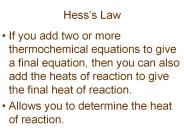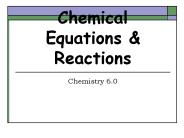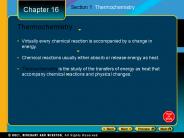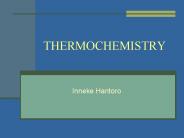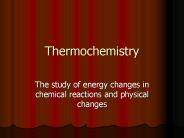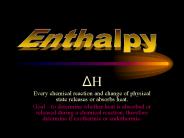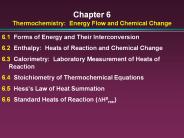Thermochemical Reaction PowerPoint PPT Presentations
All Time
Recommended
... C) or calories/gram Kelvin (cal/g K) or calories/gram Celsius ... When carbon is burned in a limited supply of oxygen, carbon monoxide and is produced. ...
| PowerPoint PPT presentation | free to view
Chapter 6 Energy & Chemical Reactions General Chemistry I T. Ara d) Manipulating Thermochemical Equations Given the following equation: N2 (g) + 3 H2 (g) 2 NH3 (g); H ...
| PowerPoint PPT presentation | free to view
Heat in Chemical Reactions 10.1 Chemical Reactions that Involve Heat Heat: Energy (symbol - q) that is transferred from one object to another due to a ...
| PowerPoint PPT presentation | free to view
Stoichiometry. Energy balance : = 0. At ... Stoichiometry. And then, energy balance... to find X = f (T) Case 1, ... Stoichiometry : Operation of a tubular ...
| PowerPoint PPT presentation | free to view
Energy Changes in Chemical Reactions *
| PowerPoint PPT presentation | free to view
... cubic equation of state (vdW)for non-ideality we get a value of 0.33. ... drops by about 10% due to non-ideality of the gas, the increase in pressure from ...
| PowerPoint PPT presentation | free to view
already cheaper than gasoline, using domestic resources. ... (STIRLING ENGINE) UREA. DECOM- POSITION. UREA. DECOM- POSITION. UREA. UREA. UREA. NH3. H2. NH3 ...
| PowerPoint PPT presentation | free to view
... Heat energy goes into heating up the water and the calorimeter ... Things are getting all messed up! Nature Loves Disorder. 53. Entropy = measure of disorder ...
| PowerPoint PPT presentation | free to view
The Reaction module Reaction calculates the thermochemical properties of a species, a mixture of species or a chemical reaction. Reaction accesses only compound ...
| PowerPoint PPT presentation | free to download
Chapter 8: Chemical Equations and Reactions pp. 260-297 The evolution of energy as light and heat is an indication that a chemical reaction is taking place.
| PowerPoint PPT presentation | free to view
Energy Relationships in Chemical Reactions. Chapter 6. Energy is the capacity to do work ... Energy Changes in Chemical Reactions. Temperature is a measure of ...
| PowerPoint PPT presentation | free to view
890.4 kJ are released for every 1 mole of methane that is combusted at 250C and 1 atm. ... How much heat is released per mole of benzene combusted? ...
| PowerPoint PPT presentation | free to view
The Adiabatic UT-3. The Sulfur-Iodine Reaction. H2 Production & Nuclear Reactors ... Adiabatic (Tokyo) UT-3. Sulfur-Iodine (Bunsen) ...
| PowerPoint PPT presentation | free to view
Chapter 15 - Standard enthalpy change of a reaction * Standard Enthalpy Changes Hana Amir and Madeley Definition Any reaction that depends on temperature, pressure ...
| PowerPoint PPT presentation | free to view
B. Enthalpy, H - The Thermal Energy gained. or lost by a system when the system under ... Standard Enthalpy of Formation - DHf. The enthalpy change accompanying ...
| PowerPoint PPT presentation | free to view
... in a molecule, the more different ways those atoms can be arranged, e.g., the atoms in C20H42 can be arranged in 366,319 different ways or C30H62 in 4,111,846, ...
| PowerPoint PPT presentation | free to view
Chapter 6 Thermochemistry Overview Understanding Heats of Reaction Energy and its Units Heat of Reaction Enthalpy and Enthalpy Change Thermochemical Equations ...
| PowerPoint PPT presentation | free to download
Thermochemistry: The heat energy of chemical reactions heat Enthalpy is the amount of _____ transferred during a reaction. The symbol for the change in enthalpy ...
| PowerPoint PPT presentation | free to view
5.4: Enthalpies of Reactions Louis Johnson, Zaineb Alattar, & Marita Inglehart Definitions Energy: the ability to do work or produce heat Work: a force acting over ...
| PowerPoint PPT presentation | free to download
qv (w = 0) Constant Volume (Bomb) Calorimeter. IV. Enthalpy ... Enthalpy: heat content of a substance at constant pressure. More important terms: ...
| PowerPoint PPT presentation | free to view
Hess s Law If you add two or more thermochemical equations to give a final equation, then you can also add the heats of reaction to give the final heat of reaction.
| PowerPoint PPT presentation | free to download
(1 atm, 25oC, 1M if aq soln) Remember these conditions! 3. 3. Thermochemical Equations ... You do not need to construct an enthalpy diagram to solve this problem. 17 ...
| PowerPoint PPT presentation | free to view
Chemical Equations & Reactions Chemistry 6.0
| PowerPoint PPT presentation | free to view
Section 1 Thermochemistry Chapter 16 Thermochemistry Virtually every chemical reaction is accompanied by a change in energy. Chemical reactions usually either absorb ...
| PowerPoint PPT presentation | free to view
Bomb Calorimetry constant volume often used for combustion reactions heat released by reaction is absorbed by calorimeter contents need heat capacity of calorimeter
| PowerPoint PPT presentation | free to download
THERMOCHEMISTRY Inneke Hantoro INTRODUCTION Thermochemistry is the study of heat changes in chemical reactions. Almost all chemical reactions absorb or release energy ...
| PowerPoint PPT presentation | free to download
Thermochemistry The study of energy changes in chemical reactions and physical changes Energy The ability to do work Energy changes in chemical reactions and physical ...
| PowerPoint PPT presentation | free to download
15.4: Pgs. 534 - 541 Main Idea The enthalpy change for a reaction is the enthalpy of the products minus the enthalpy of the reactants Hess s Law Most reactions ...
| PowerPoint PPT presentation | free to view
Exothermic reactions release energy as a product (H is negative) Phase Diagram ... H of a reaction (e.g., acid/base or any endothermic or exothermic reaction) ...
| PowerPoint PPT presentation | free to view
Enthalpy change that accompanies a chemical reaction is called the enthalpy of reaction, DHrxn ... Enthalpy is an extensive property. ...
| PowerPoint PPT presentation | free to view
Hess s Law 17.4 Hess s Law If a series of reactions are added together, the enthalpy change for the net reaction will be the sum of the enthalpy changes for the ...
| PowerPoint PPT presentation | free to download
Stoichiometry: Chemical Calculations Chemistry is concerned with the properties and the interchange of matter by reaction structure and change.
| PowerPoint PPT presentation | free to download
for exothermic reactions, (a) in isolated systems, system T ... For problem-solving, heat evolved (exothermic reaction) can be thought of as a product. ...
| PowerPoint PPT presentation | free to view
There are several applications for hydrogen, an energy source that is flexible and clean. Hydrogen is the most common and lightest chemical element in the universe. Hydrogen, which is the building block of the cosmos, is also necessary for a variety of chemical reactions and processes.
| PowerPoint PPT presentation | free to download
... to evolved N2 Sulfide oxidized to dissolved sulfate High-Temperature Calorimetry 700oC 25oC 700oC 25oC 700oC 25oC DS TTD SOL Thermochemical Cycles ...
| PowerPoint PPT presentation | free to download
How do enthalpy and entropy affect reactions. 2. How do you use Hess' Law ... The enthalpy change for this reaction is 1646 kJ/mol , so the average bond ...
| PowerPoint PPT presentation | free to view
Chapter 16 - Energy and Chemical Change Energy and Heat Thermochemistry - concerned with heat changes that occur during chemical reactions Energy - capacity for doing ...
| PowerPoint PPT presentation | free to view
Chapter 16 Preview Objectives Thermochemistry Heat and Temperature Specific Heat Enthalpy of Reaction Enthalpy of Formation Stability and Enthalpy of Formation
| PowerPoint PPT presentation | free to download
Photochemistry in the Atmospheres of. Hot Jupiters. Yuk L. Yung1, Mao-Chang Liang2, ... Common photochemistry: hundreds of molecules, thousands of reactions ...
| PowerPoint PPT presentation | free to download
... is energy that transfers from one object ... concerned with heat changes that occur during chemical reactions Energy - capacity for doing work or supplying heat ...
| PowerPoint PPT presentation | free to download
H Every chemical reaction and change of physical state releases or absorbs heat. Goal to determine whether heat is absorbed or released during a chemical ...
| PowerPoint PPT presentation | free to download
Thermochemistry: Energy Flow and Chemical Change 6.1 Forms of Energy and Their Interconversion 6.2 Enthalpy: Heats of Reaction and Chemical Change
| PowerPoint PPT presentation | free to download
Hydrogen is a clean, flexible energy source with a variety of applications. The most prevalent and lightest chemical element in the universe is hydrogen. The building block of the universe, hydrogen, is also required for a wide range of chemical reactions and processes. Read More - https://www.marketsandmarkets.com/industry-practice/hydrogen/hydrogen-technologies-comparison
| PowerPoint PPT presentation | free to download
Calorimetry The enthalpy change associated with a chemical reaction or process and the specific heat of a substance can be measured experimentally using calorimetry.
| PowerPoint PPT presentation | free to view
Enthalpy change that accompanies a chemical reaction is called the enthalpy of reaction, DHrxn ... One mole of water weighs 18.02 g (MM H2O = 18.02 g/mol) so: ...
| PowerPoint PPT presentation | free to view
6.3 Calorimetry: Laboratory Measurement of Heats of Reaction ... When gasoline burns in a car engine, the heat released causes the combustion ...
| PowerPoint PPT presentation | free to download
Thermochemistry Lesson # 4: Hess s Law Enthalpy in Chemical Reactions From experimental evidence we have determined that the change of enthalpy in chemical ...
| PowerPoint PPT presentation | free to download
hot, concentrated ammonia:water mixtures, short reaction time ... Rural/regional/national economic development. Processing. Biomass. Biomass. Relative Cost ...
| PowerPoint PPT presentation | free to view
Thermochemistry - concerned with heat changes that occur during chemical reactions ... Gasoline contains a significant amount of chemical potential energy ...
| PowerPoint PPT presentation | free to view
Look at Table I: Heats of Reaction. Rxns 1-7: combustion rxns or rxn with O2 ... heat of combustion. Rxns 8-18: formation reactions. 1 mole of substance is ...
| PowerPoint PPT presentation | free to view
Hess s Law Thermochemistry Hess s Law Germaine Henri Hess (1802-1850) is important primarily for his thermochemical studies. Hess s Law states that the heat ...
| PowerPoint PPT presentation | free to view
Performance Estimates for Sulfur-based Thermochemical Hydrogen Cycles using OLI Max Gorensek, PhD, PE Senior Fellow Engineer Computational and Statistical Science
| PowerPoint PPT presentation | free to download
Thermochemistry The study of energy changes that occur during chemical reactions and changes of state. The Universe Can be divided into 2 parts System- the part ...
| PowerPoint PPT presentation | free to download
Title: Reaction Fundamentals Author: Keith L. Hohn Last modified by: Brandon Utech Created Date: 7/2/2001 3:41:10 PM Document presentation format
| PowerPoint PPT presentation | free to download
Calorimeter: device used to measure heat of reaction ... First find amount of heat absorbed by calorimeter. q = smt and q = Ct ...
| PowerPoint PPT presentation | free to download
Chemical Thermodynamics Thermochemistry Thermochemistry the part of thermodynamics that involves the relationship between chemical reactions and energy changes I ...
| PowerPoint PPT presentation | free to view





















